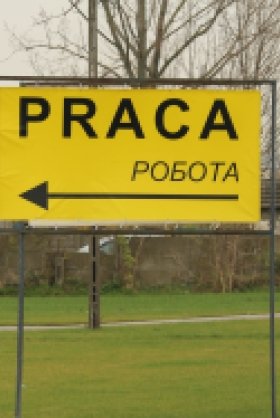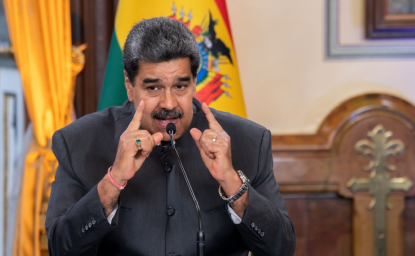Kennan Cable No. 31 - West or East: The (Un)Predictable Choice of Ukrainian Migrants


Introduction
Ukraine has suffered for years from poor governance, kleptocratic rule, a decline of living standards, and conflict seeming without end in the Donbas with separatists supported overtly by Russia. Yet there is another overlooked factor destabilizing Ukraine’s future: a human exodus. Today Ukraine ranks 9th among nations with displaced populations worldwide,[1] with 1.58 million internally displaced people in Ukraine and over 460,000 Ukrainians searching for safety abroad.[2] Ukrainian civilians forced to flee the occupied and conflict-affected territories are often called the “forgotten refugees” of Europe.[3] Ukraine has also emerged as a supplier of cheap labor for its neighbors, with 4.6 million Ukrainians seeking work abroad.[4]
However, Ukraine is not historically a country of emigrants. Large outflows of Ukrainians occur only during political, economic, or social upheavals inside the country. Over the years, Ukraine’s outward migration might vary in terms of numbers, but the main pattern of migration destinations for Ukrainian nationals stayed consistent. That pattern changed abruptly in 2014. Before 2014, the main migration flows from Ukraine were oriented east, with Russia as the primary destination. Today, the majority of Ukrainians now move west, primarily to Poland. Ukraine’s current fractured migration pattern reflects the dilemma faced by Ukraine itself: whether to choose the East (meaning Russia) or the West (meaning the EU member-states).
Going to the West
Europe has long attracted migrants from Ukraine. Ever since the collapse of the USSR, citizens from Ukraine submitted the most applications for residence permits for employment in the EU—and in turn received the most permits. That trend has only increased since the outbreak of hostilities with Russia in 2014.
Table 1. Residence permits for Ukrainian citizens in the EU-countries by reason
Total
Family
Education
Employment
Other reasons
2016
588,900
32,507
5.5%
25,873
4.4%
487,181
82.7%
43,366
7.4%
2015
499,992
29,276
5.9%
30,356
6.1%
376,037
75.2%
64,323
12.9%
2014
302,772
21,378
7.1%
22,168
7.3%
206,422
68.2%
52,804
17.4%
Source: Eurostat database
Prior to this turning point, a typical Ukrainian based his or her migration strategy mainly on the socio-economic situation at home. After 2014, new reasons emerged: political instability and the military mobilization of working-age men. In May 2017 in Kyiv, a group of researchers from Ukraine, Poland, the Czech Republic, and Slovakia introduced a study entitled “Ukrainian Migration in Times of Crisis,” which analyzed migration flows from Ukraine to the West. For the first time in the long history of Ukrainian migration, the fear of mobilization/conscription into the army registered as one of the top three main motivations for emigration.[5] The other top push factors were work and the desire to study abroad.
The search for work and better wages continues to be the top reason for people to leave Ukraine. As shown in Table 1, 499,992 Ukrainians[6] in 2015 and 588,900 in 2016 received EU residence permits for employment, primarily in Poland. The high numbers of permits granted is a consequence of the overwhelming number of applicants: Citizens of Ukraine comprised 79.4 percent of all EU residence permit applicants in 2015 and 87 percent in 2016. Ukrainians received more permits from the EU member than refugees from Syria.[7]
According to the International Organization for Migration (IOM), labor migration from Ukraine is predominantly male. Most Ukrainian labor migrants are males with a school-level or university-level education, and 40 percent of them are between the ages 30-44. The levels of male migration is yet another effect of the 2014 conflict with Russia and the mobilization of Ukraine’s male population. Prior to 2013, 67 percent of labor migrants from Ukraine to Poland were female and 33 percent male. After 2014, the balance flipped the other way, with 42 percent female and 58 percent male.
Ukrainians in search of work in the West go to Poland (14.3 percent), Italy (13.2 percent), the Czech Republic (12.8 percent), Germany (2.4 percent), Hungary (1.9 percent), and Portugal (1.8 percent). The majority of Ukrainian labor migrants still go to Russia.
Ukrainian labor migrants tend to have a special profile, depending on the EU country. In Poland, Ukrainian citizens work in agriculture, public catering, tourism, and construction. In the Czech Republic, Ukrainians work in the areas of transport and manufacturing. In Italy and Greece, they work in housekeeping, the hotel and service sector, and public catering.
Germany remains a magnet for high-skilled migrants from Ukraine. The number of Ukrainian citizens issued a blue card (an authorization for highly qualified professionals to work in the territory of Germany) and starting their own business is growing from year to year:[8] The military conflict in eastern Ukraine also led to an upsurge in ethnic migration. For the first time during the last 10 years, migration of Jews and ethnic Germans from Ukraine to Germany has dynamically increased[9].
Germany is far from the primary destination for Ukrainian migrants. The past, present and (very likely) future of Ukrainian migration to the West centers on its western neighbor: Poland. Poland itself is a net donor of migrants to the West while at the same time serving as a host country for migrants from the East. The migration flows from Ukraine in large part replace Poland’s human capital and labor resources that itself has gone west. Poland recognizes this need, and uses different mechanisms and programs to stimulate the number of Ukrainian citizens coming to Poland for short- and long-term stays in Poland.
One such policy is the Karta Polaka (Pole’s Card) which targets citizens of post-Soviet nations, primarily Ukraine and Belarus that have Polish roots. Issued for a period of up to 10 years (after which it can be renewed), the card guarantees to its holder a range of rights anywhere in Poland: the right to employment; the right to set up a business and freely engage in entrepreneurial activities on an equal footing with locals; to study free-of-charge at high schools, vocational schools, and universities; to apply for a stipend or a full or partial reimbursement of a tuition fee in Poland’s educational institutions; to receive a 37 percent discount on railway tickets; to visit the state-run museums for free; to apply for financial assistance from the national or municipal funds; and other benefits as well.
A holder of a Pole´s Card who decides to move from his country of residence to Poland is entitled to a special monthly financial allowance of $260 for every adult and $130 for accompanied minors. Additionally, the Polish government provides additional assistance, including free-of-charge intensive Polish language instruction and help finding and renting an apartment. As of June 2016, Poland had issued about 70,000 cards to Ukrainian citizens and about 75,000 cards to Belorussian citizens. Belarus views this program of repatriation of Belarusian citizens of Polish descent as a threat rather than an opportunity, and the Belorussian constitutional court has ruled that this program is contrary to the Republic of Belarus’ interests. Certain categories of Belorussian citizens (including public servants and employees of municipal organs) are banned from using the card.[10]
The number of young Ukrainians moving abroad in search of educational opportunities continues to grow. During 2014-15, approximately 59,600 students went abroad. In 2015-16, that number exploded to over 68,000—with 32,000 of them going to Poland, 15,700 to Russia, and 8,000 to Germany. Educational migration from Ukraine has a “female” face, as women predominate among Ukrainians studying abroad in all countries except Turkey.
Russia is no longer the top destination for Ukrainian students going abroad. Starting in 2014, in the wake of Russia’s annexation of Crimea and the onset of Russian-Ukrainian military conflict, Western Europe emerged as the top choice for Ukrainian students. Two-thirds of Ukrainians studying in Germany pursue degrees in the sciences, while two-thirds of Ukrainian students in Poland focus on the humanities.[11]
Ukrainian citizens also flock to the West in search of shelter and international protection.[12] Ukraine is among the top ten countries whose citizens come to United States in search of protection and shelter. In fiscal year 2016,[13] the U.S. government received 2,543 applications from Ukrainian citizens seeking protected status (3 percent of the total applications filings). Over the next 10 months, October 2016-August 2017, that number grew to 2,869 (totaling 6.8 percent of filings during that period).
Ukrainian citizens apply for asylum in EU countries as well. The top five countries where Ukrainians applied for asylum in 2014-2016 were (in descending order) Spain, Italy, Germany, Sweden, and France.
Humanitarian migration to the West is a new and relatively small trend in migration from Ukraine. Most Ukrainian citizens move to the EU and the United States in pursuit of educational opportunities or work.
Going to Russia
For decades, the Russian Federation had been Ukrainian emigres’ preferred destination for work and study. However, the Russian-Ukrainian conflict completely transformed the movement of populations between Ukraine and Russia.
Historically, western Ukraine supplied most of Ukraine’s migrants, both to the East and to the West. Until 2013, 93.7 percent of Ukrainian migrants originated from the western part of Ukraine and only 6.3 percent from its eastern regions. After 2014 that proportion changed. Among Ukrainians who left the country, residents of its eastern regions accounted for 28.4 percent, and residents of its western regions for 71.6 percent.[14] Because of the historical, cultural, and linguistic ties Ukraine’s eastern regions have to Russia, most residents leaving eastern Ukraine have chosen Russia as their country of destination.
In 2016, the majority of all new migrants to Russia were of Ukrainian origin. By the first quarter of 2017, the number of Ukrainians coming to Russia declined by 10-12 percent. According to official statistics, 1.6 million Ukrainians moved to Russia in May 2014. In 2015 that number increased to 2.5 million Ukrainians; and in 2016, the number increased again to 2.3 million. The following year, the number of Ukrainians moving to Russia declined slightly to 2.2 million. [15]
The main push factors contributing to mobility from Ukraine to Russia are employment, education, humanitarian protection, and the resettlement of so-called “compatriots.” Temporary labor migration remains the backbone of population flows between Ukraine and Russia, even during the Russian-Ukrainian conflict. In Russia, Ukrainians work in construction (38 percent), the industrial sector (20 percent), commerce (10 percent), agriculture (8 percent), public services (8 percent), transportation (7 percent), and other sectors.[16] Not surprisingly, before the conflict, Ukraine was one of the largest beneficiaries of migrant remittances from Russia. In 2013, the volume of remittances sent by private individuals from Russia to Ukraine was $3.78 billion, or 1.6 percent of Ukraine’s GDP. By 2016, that figure plunged to $622 million, or 0.6 percent of Ukraine’s GDP.
In the last three years, the volume of money transfers between the countries has been steadily declining. At the outbreak of the Russian-Ukrainian conflict, private remittances accounted for 14 percent of all transfers from Russia to Ukraine. That number fell to 9.2 percent in 2015, and then to 8.4 percent in 2016. The military conflict on the territory of Ukraine and economic recession in Russia were not the only reason for this decline—escalating financial sanctions between Russia and Ukraine played a major role as well.
In November 2016, Ukraine’s President Poroshenko issued a directive introducing sanctions against six Russian money transfer systems, included Golden Crown (27 percent of the total money transfer market from Russia to Ukraine), Unistream from Unistream Bank (10 percent), Blizko (4 percent), money transfer system Kolibri from Sberbank Bank (less than 4% of the money transfer market).[17] In response, the following year the Russian parliament adopted legislation restricting money transfers by private individuals from Russia to countries that impose restrictions on the operations of Russian money transfer systems. In their explanatory note, the authors of the draft law clearly stated that the law was a response to the Ukrainian government’s restrictions on Russian money transfer systems.[18] These mutual sanctions will result in increased costs for money transfers and remittances, primarily affecting Ukrainian migrants.
Mutual sanctions, geopolitical confrontation, and social-political tension between Russia and Ukraine have made the Russian labor market far less attractive to Ukrainians looking for temporary work, but a new resettlement program for Russian-speaking Ukrainians is attracting interest. Since 2014, Russia has introduced a program of resettlement for Ukrainian citizens of Russian ancestry. The program assists eligible Ukrainian citizens, including fast-track procedures for securing temporary and permanent residence permits, employment authorization, and even for obtaining Russian citizenship. According to Russia´s Ministry of Internal Affairs, 100,696 Ukrainian nationals received Russian passports in 2016 (a 49 percent increase over 2015). Demand from Ukrainians for this program remains high. In 2016, more than 50 percent of applications to Russia´s resettlement program came from Ukrainian citizens, 95.3 percent of whom were already residing in Russia.[19]
Moving to Russia for educational purposes still attracts Ukrainian nationals. This was, and remains, a goal of Russian state policy. In 2014, Russia’s Ministry of Education and Science approved a list of 17 national institutions of higher learning (IHLs) and 176 vocational colleges eligible to accept students from eastern Ukraine and provided publicly-financed support for up to 2,500 students. Prior to 2014, the quota assigned to Ukraine was capped at approximately 300. In addition, Russia’s President Putin signed a decree in February 2017 that simplified the procedure for Ukrainian citizens from Donetsk and Luhansk to apply to Russian higher educational institutions.[20] Today, there are 15,978 students studying in Russia from Ukraine, placing the country in third place after Kazakhstan and Belarus for students studying in Russia during 2015-2016.[21]
Conclusions
Ukraine is losing its human capital in terms of quantity and quality. Consequently, Ukraine confronts two main challenges concerning its demographic future. The first is to find an appropriate response to Ukraine’s declining population: how to increase life expectancy, birth rates, and living standards within the country. At current rates, by 2050 Ukraine´s population decline is projected to fall to 32.9 million (a 9.9 percent drop from 2016), with people older than 60 accounting for more than 50 percent of its population.[22]
The second challenge is to address the qualitative decline of the country´s population and attract back the qualified people that moved to Russia and to the West. As it stands now, Ukraine is losing younger and better-educated citizens, particularly to the West.
It is obvious that Ukraine cannot solve its pressing troubles in terms of poor governance, a rise of the kleptocracy, a decline of living standards, and unending conflict across its border with Russia on its own. But Ukraine should find a way to solve its demographic challenge itself. Migration, whether to the east (meaning Russia) or to the west (meaning to EU countries), threatens to destabilize Ukraine, and is an urgent concern for the country’s future.[23]
[1] UNHCR (2017): Global Trends. Forced Displacement in 2016. http://www.unhcr.org/5943e8a34.pdf
[2] UNHCR (2017): Ukraine. Operational Update of June, 2017.
[3] Mitchneck, B., Zavisca, J., Gerber, T. (2016): Europe's Forgotten Refugees. The Humanitarian Crisis in Ukraine. https://www.foreignaffairs.com/articles/ukraine/2016-08-24/europes-forgotten-refugees-0
[4] Milakovsky, B. (2018): Ukrainians Abroad: The Economics and Politics of Labor Migration. http://www.kennan-focusukraine.org/ukrainians-abroad-the-economics-and-politics-of-labor-migration/
[5] https://www.osw.waw.pl/sites/default/files/projekty/ukrainian_migration_in_time_of_crisis.pdf
[6] Eurostat Press Release (2016): Residence permits for non-EU citizens. 211/2016 - 27 October 2016
[7] Eurostat Press Release (2017): Residence permits for non-EU citizens. 174/2017 - 16 November 2017.
[8] http://www.bamf.de/SharedDocs/Anlagen/EN/Publikationen/Migrationsberichte/migrationsbericht-2015.html
[9]http://www.bamf.de/SharedDocs/Anlagen/EN/Publikationen/Migrationsberichte/migrationsbericht-2015.html
[10] http://www.kc.gov.by/main.aspx?guid=23203
[11] Українські студенти за кордоном: скільки та чому? https://cedos.org.ua/uk/osvita/ukrainski-studenty-za-kordonom-skilky-ta-chomu
[12] MPI analysis of State Department WRAPS data. Source: Zong, Jie & Batalova, Jeanne (2017): Refugees and Asylees in the United States. MPI
[13]FY 2016 means from October 1, 2015 through October 1, 2016.
[14] http://www.financialobserver.eu/poland/a-new-wave-of-ukrainian-migration-to-poland/
[15] ГУВМ МВД РФ, ЦБДУИГ 2017
[16] http://intertrends.ru/system/Doc/ArticlePdf/1091/pba3ngxk3d.pdf
[17] Statistics of the National Bank of Ukraine. https://www.ukrinform.ru/rubric-economix/2198095-v-plateznoj-vojne-ukrainarossia-vyigrali-amerikancy.html
[18] http://www.consultant.ru/cons/cgi/online.cgi?req=doc&base=PRJ&n=116914&dst=100001#0
[19] https://xn--b1aew.xn--p1ai/upload/site1/document_file/Monitoring_realizacii_Gosudarstvennoy_programmy_za_I_kvartal_2016_goda.pdf
[20] http://kremlin.ru/events/president/news/53895
[21] http://www.vedomosti.ru/management/articles/2015/02/19/student-stupenka-k-rejtingu
[22] Source: The Institute of the Demography and Social Studies at the National Academy of Science of Ukraine.
[23] Acknowledgment: This research project was supported by Kennan Institute of the Wilson Center and benefitted from discussions with Ukrainian experts, migrants, stakeholders, and academics in Kyiv, Ukraine in May, 2016. The author thanks Prof. Olena Malinovskaya and Dr. Olexiy Poznyak for their critical comments and suggestions, as well as Mr. Joseph Dresen and the Kennan Institute their support and cooperation.
Author

Founder & CEO of the RUSMPI – Institute on Migration Policy

Kennan Institute
The Kennan Institute is the premier US center for advanced research on Eurasia and the oldest and largest regional program at the Woodrow Wilson International Center for Scholars. The Kennan Institute is committed to improving American understanding of Russia, Ukraine, Central Asia, the South Caucasus, and the surrounding region through research and exchange. Read more

Explore More
Browse Insights & Analysis
360° View of How Southeast Asia Can Attract More FDI in Chips and AI


